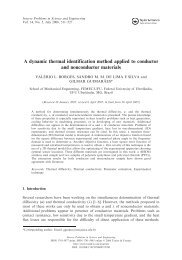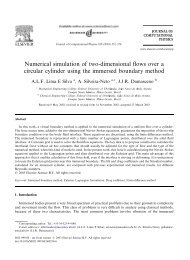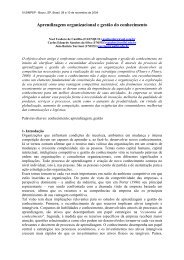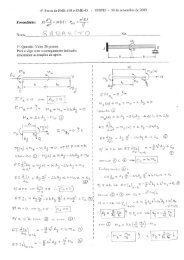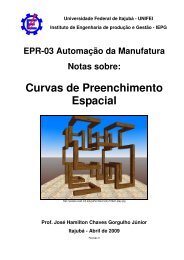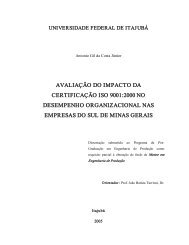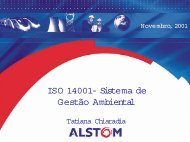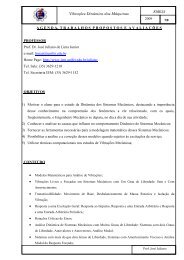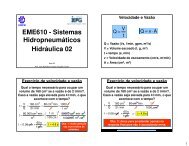Evaluation and analysis of criteria and sub-criteria of a ... - Emerald
Evaluation and analysis of criteria and sub-criteria of a ... - Emerald
Evaluation and analysis of criteria and sub-criteria of a ... - Emerald
You also want an ePaper? Increase the reach of your titles
YUMPU automatically turns print PDFs into web optimized ePapers that Google loves.
ECAM15,136might not be applicable in other industries. This might limit the ability <strong>of</strong>organisations to benchmark across industries.Conclusion <strong>and</strong> further workThe evaluation <strong>and</strong> <strong>analysis</strong> <strong>of</strong> the <strong>criteria</strong> <strong>and</strong> <strong>sub</strong>-<strong>criteria</strong> <strong>of</strong> a ConstructionExcellence Model was presented in this paper. The evaluation <strong>and</strong> <strong>analysis</strong> was basedon similar evaluations <strong>and</strong> analyses <strong>of</strong> TQM frameworks <strong>and</strong> excellence models inquality management literature. The <strong>analysis</strong> addressed the issue <strong>of</strong> data preparation,where missing data were analysed <strong>and</strong> appropriate data replacement methods used tocomplete the data set. The questionnaire as a measuring instrument was evaluated interms <strong>of</strong> reliability using Cronbach’s alpha, which resulted in the omission <strong>of</strong> the“Society <strong>and</strong> environmental impact <strong>of</strong> projects” <strong>sub</strong>-criterion from the “Projectperformance” criterion. Reliability <strong>of</strong> the measuring instrument is a necessary but notsufficient condition for validity. The validity <strong>of</strong> the measuring instrument is furtherevaluated in terms <strong>of</strong> content, construct <strong>and</strong> criterion-related validity using techniquesas factor <strong>analysis</strong>, multiple correlation. The <strong>criteria</strong> <strong>and</strong> <strong>sub</strong>-<strong>criteria</strong> were confirmedthrough their importance ratings <strong>and</strong> actual effectiveness ratings employingconfidence intervals <strong>and</strong> exploratory <strong>and</strong> confirmatory factor <strong>analysis</strong>. Theevaluation <strong>and</strong> <strong>analysis</strong> <strong>of</strong> the model’s <strong>criteria</strong> <strong>and</strong> <strong>sub</strong>-<strong>criteria</strong> strengthens themodel’s validity. The weights <strong>of</strong> the <strong>criteria</strong> were calculated using empirical data <strong>and</strong>the method <strong>of</strong> factor regression coefficients.A number <strong>of</strong> future researches can be conducted in continuation <strong>of</strong> this researchpaper. The scope <strong>of</strong> the model could be exp<strong>and</strong>ed to suit the needs <strong>of</strong> other types <strong>of</strong>construction organisations, such as consultants <strong>and</strong> owner organisations.Modifications could include, for example, modifying the relative criterion weights inthe Construction Excellence Model, for different types <strong>of</strong> organisations. Theconsideration <strong>of</strong> organisation size is another area <strong>of</strong> possible research, wherespin-<strong>of</strong>f models could be developed for small <strong>and</strong> medium enterprises. In addition, thecriterion weights <strong>of</strong> national Excellence Models such as EFQM <strong>and</strong> Baldrige requireempirical justification. Finally, within the Construction Excellence Model, alternativemethods for computing criterion weights can be applied such as the analytic hierarchyprocess.ReferencesAhire, S.L., Golhar, D.Y. <strong>and</strong> Waller, M.A. (1996), “Development <strong>and</strong> validation <strong>of</strong> TQMimplementation constructs”, Decision Sciences, Vol. 27 No. 1, pp. 23-56.Ahmad, I.U. <strong>and</strong> Sein, M.K. (1997), “Implementing TQM principles in construction projects:difficulties <strong>and</strong> remedies”, International Conference on Leadership <strong>and</strong> Total QualityManagement in Construction <strong>and</strong> Building, CI Premier Conference, Singapore, pp. 47-54.Anderson, J.C., Rungtusanatham, M., Schroeder, R.G. <strong>and</strong> Devaraj, S. (1995), “A path analyticmodel <strong>of</strong> a theory <strong>of</strong> quality management underlying the Deming management model:preliminary empirical findings”, Decision Sciences, Vol. 26 No. 5, pp. 637-58.Bassioni, H.A., Price, A.D.F. <strong>and</strong> Hassan, T.M. (2004a), “Theoretical formulation <strong>of</strong> a frameworkfor measuring business performance in construction”, in Ruddock, L., Sexton, M.,



